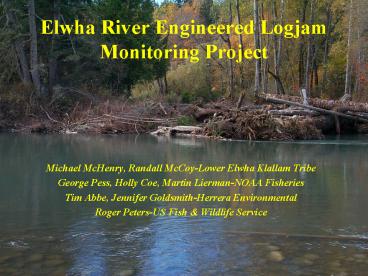Elwha River Engineered Logjam Monitoring Project - PowerPoint PPT Presentation
1 / 50
Title:
Elwha River Engineered Logjam Monitoring Project
Description:
Elwha River Engineered Logjam Monitoring Project – PowerPoint PPT presentation
Number of Views:48
Avg rating:3.0/5.0
Title: Elwha River Engineered Logjam Monitoring Project
1
Elwha River Engineered Logjam Monitoring Project
- Michael McHenry, Randall McCoy-Lower Elwha
Klallam Tribe - George Pess, Holly Coe, Martin Lierman-NOAA
Fisheries - Tim Abbe, Jennifer Goldsmith-Herrera
Environmental - Roger Peters-US Fish Wildlife Service
2
(No Transcript)
3
Engineered Logjam (ELJ) Technology
- Based on the architecture of naturally occurring,
stable log jams. - Accommodate natural channel dynamics
disturbance regimes. - Meet traditional engineering standards while
providing greater habitat value. - Restore natural function and habitat complexity,
recognize opportunities for entire system. - Work within constraints of system (i.e., bridges,
development).
4
Meander Jam
5
Bar Apex Jam
6
EC
- RM 1.3-2.2
- Manage Flow Splits
- 21 ELJs (2000-2004)
- BAJ/Meander Types
- Distribute Flows
- Increase Habitat
HRC
SC-5
7
Elwha ELJ Characteristics
8
Study Design
Biological
Physical
- Stability
- Distribution of Flows
- Sediment
- Wood
- Habitat
- Primary productivity
- TOC/Chlorophyll a
- Secondary productivity
- Macroinvertebrates
- Juvenile fish
- Abundance
- Movement
- Adult Fish
- Redd mapping
9
Peak Flows 1898-2004
10
ELJ Performance
- 21 of 21 structures intact
- 20 of 21 have formed pools
- Net gain in LWD
- No significant decay
- Bank erosion reduced
- Various stages of revegetation
11
Distribution of Flows
- Stage dependent
- Summer base flows lt25 cfs in east channel
- EC functioning as Ground Water SC
- Additional actions my be necessary to balance low
flows
12
Effects on Habitat Reach Scale
13
Pool Development
14
Pool Depth Frequency
15
Temperature Effects
16
1994
2006
17
Reach Scale Sediment Storage
18
Particle Size Distribution Change
19
(No Transcript)
20
Visual Substrate Effects
21
Spawning Habitat Created
22
ALGAE ( OTHER ORGANIC MATTER)
NUTRIENTS
23
Primary Productivity
24
Primary Productivity
25
Secondary Productivity
26
(No Transcript)
27
(No Transcript)
28
Juvenile Fish
- Snorkel Observations
- Habitat Based
- ELJ v Non-ELJ
- Complex v Simple
- Analysis
- Proportion
- Density
- Biomass
29
- Proportion
- Juvenile salmonid density was consistently
greater in ELJ than non-ELJ bank units in 75
species/size class categories.
Grey bar logjam units White bar non logjam
units
30
- Density
- 50 of species/size class categories had
consistently significant differences in densities
due to habitat complexity.
white highly complex light grey moderately
complex dark grey low complexity
31
- Biomass
- The greatest difference between ELJ and non-ELJ
bank units occurred with biomass estimates.
Grey bar logjam units White bar non logjam
units
32
- Season
- Biomass estimates exhibit a strong pattern of
significant differences for juvenile, sub-adult,
and resident salmonids during the summer.
white highly complex light grey moderately
complex dark grey low complexity
33
(No Transcript)
34
Juvenile Fish Basic Conclusions
- The patterns suggest that the proportion of
occurrence, median density and biomass of
juvenile, sub-adult, and resident salmonids in
bank units were positively influenced by ELJs. - Statistical certainty was clouded by high
variability in numbers, methods, and fish
behavior.
35
Wood Budget Redd Mapping
36
Increasing Wood
37
(No Transcript)
38
Local Sources Movement
39
2001 LWD No Redd Data
40
2001 LWD 2002 Redds
41
2002 LWD 2002 Redds
42
2002 LWD 2003 Redds
43
2004 LWD 2003 Redds
44
2004 LWD 2004 Redds
45
2006 LWD 2006 Redds
46
Conclusions
- All structures intact after 20 Bankfull Floods
- Positive changes in scour depth, sediment
storage, substrate, temperature, bank erosion
rates and flow patterns documented - Primary production higher on ELJ surfaces
- Invertebrate production and diversity higher on
ELJ surfaces - Consistent differences observed for juvenile
salmon (particularly proportion and biomass) - Methods used in this study were not adequate to
assess fish survival and productivity questions.
47
Conclusions (cont.)
- ELJs can be an effective reach scale tool to
manage sediment deposition and floodplain
reconnection. - ELJs can be an effective reach scale tool to
manage chronic bank erosion. - ELJs can be an effective reach scale tool tool
to manage flow and therefore habitat area. - Restoring large scale habitat forming processes
(connectivity, floodplain forests, etc..) is key
to the health of large rivers.
48
(No Transcript)
49
Policy Gut Check
- effective river rehabilitation that produces
lasting and fundamental changes in river
integrity and biodiversity is going to be a long,
hard and expensive operation. - Andrew Brooks
(Geomorphology 79395-422)
50
Thank You SRFB/IAC!
- Acknowledgements
- NOAA-Sarah Morley, Todd Bennett, Kris Kloehm,
Peter Kiffney - LEKT-Mel Elofson, Sonny Sampson, Ray Moses,
Phillip Blackcrow, Jim Bolstrom, Roger Hopie,
Keith Charles - Sisson Family
- Four Seasons Engineering
- Wengler Surveying































